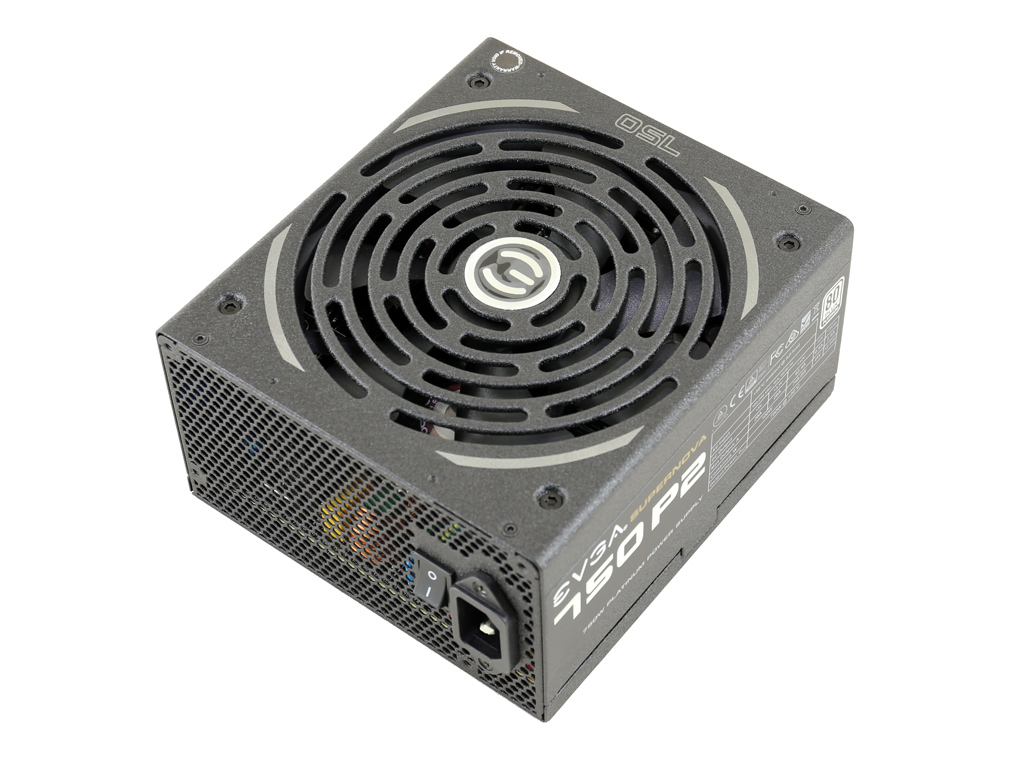Tom's Hardware Verdict
The 750 P2 is a top-notch PSU with low ripple on all rails, tight load regulation and high efficiency. Its fully modular cable design along with the selectable semi-passive operation, the Japanese caps and the 10-year warranty complete the package. With a richer, in operational modes, fan profile and a lower speed fan this PSU would offer an even more silent operation, which is highly desired by many users nowadays.
Pros
- +
Full power at 49°C
- +
Efficient
- +
Ripple Suppression
- +
Load regulation
- +
Silent at light-moderate loads
- +
Hold-up time
- +
Quality caps
- +
Fully modular
- +
Semi-passive operation
- +
Warranty
Cons
- -
Weak and not so efficient 5VSB rail
- -
Short distance between 4-pin Molex and SATA connectors
- -
Fan profile
Why you can trust Tom's Hardware
Introduction
Until now, the only power supply from EVGA's high-end P2 family that we hadn't reviewed was the SuperNOVA 750. We couldn't let that stand, particularly since the 750W category is one of the most popular.
Previously, the 650W and 850W P2s impressed us enough to earn awards. So the SuperNOVA 750 P2 is going into today's piece with an advantage of sorts; after all, it employs the same Super Flower platform. Before its alliance with EVGA, Super Flower was mostly only known to PSU connoisseurs. Nowadays, it's a much more familiar name.
The 750 P2 is clearly a premium piece of hardware. It's based on a high-end platform that uses Japanese caps exclusively and comes loaded with quality components. Other interesting features include modular cabling, a selectable semi-passive mode and a hefty 10-year warranty, which was EVGA's strongest asset up until recently. Corsair stepped up to match it across the company's top PSU families, though. When it comes to power supplies, guaranteeing against failures can prove fatal to a company's finances over the long run. But EVGA and Corsair seem confident in the longevity of their products, otherwise they wouldn't commit to such long warranties.
Specifications
The SuperNOVA 750 is 80 PLUS Platinum-rated and, again, all of its cables are modular. EVGA claims this unit can deliver its full power continuously at up to 50 °C, and according to our experience so far with other Super Flower platforms, we don't doubt this is true. The list of protection features is notably missing OCP for the +12V rail, since this is a single +12V rail PSU, and over-temperature protection. We strongly believe that all PSUs should implement OTP, especially the ones with a semi-passive fan mode.
The PSU's cooling is handled by a double ball-bearing fan with a relaxed profile. Under real-world conditions you'll have a hard time getting the fan to spin at full speed. We had to push taxing loads through the SuperNOVA 750 P2 in a hot environment to make the fan work.
Physically, the PSU s normal-sized, and again we love the long warranty. It's a great advantage over competing PSUs, and we're pretty sure that, for many enthusiasts, this coverage alone will be a key purchasing factor.
Power Specifications
Get Tom's Hardware's best news and in-depth reviews, straight to your inbox.
| Rail | 3.3V | 5V | 12V | 5VSB | -12V | |
|---|---|---|---|---|---|---|
| Max. Power | Amps | 20 | 20 | 62.4 | 2.5 | 0.5 |
| Watts | 100 | 748.8 | 12.5 | 6 | ||
| Total Max. Power (W) | 750 |
The minor rails can only provide 100W combined, though that should suffice for most modern systems. The single +12V rail is pretty strong; it'll easily support two high-end graphics cards. We'd like to see a beefier 5VSB rail with at least 3A max current output, though.
Cables And Connectors
| Modular Cables | ||
|---|---|---|
| Description | Cable Count | Connector Count (Total) |
| ATX connector 20+4 pin (600mm) | 1 | 1 |
| 4+4 pin EPS12V (700mm) | 2 | 2 |
| 6+2 pin PCIe (700mm) | 2 | 2 |
| 6+2 pin PCIe (700mm) / Six-pin PCIe (+150mm) | 2 | 2 / 2 |
| SATA (550mm+100mm+100mm) | 2 | 6 |
| SATA (550mm+100mm+100mm+100mm) | 1 | 4 |
| Four-pin Molex (550mm+100mm+100mm+100mm) | 1 | 4 |
| FDD Adapter (+100mm) | 1 | 1 |
EVGA's SuperNOVA 750 P2 has the same cable/connector configuration as the 850 P2. You get two EPS and six PCIe connectors, all of which are available at the same time. A pair of the PCIe connectors only has six pins (rather than eight). So, on paper at least, they can deliver up to 75W each.
The number of SATA connectors is increased, while the four-pin Molex connectors should cover most storage and fan configurations. Cable length is satisfactory in general, however, the distance between SATA and peripheral connectors is too short, which could cause problems. In our opinion, there should be at least 15cm between them, since in many cases they feed components spread farther apart. Finally, the 24-pin ATX, EPS and PCIe connectors use thicker 16-gauge wires, while the other cables employ 18-gauge wires.
Power Distribution
Since this PSU features a single +12V rail, we do not have anything to say about its power distribution.
MORE: Best Power Supplies
MORE: Power Supplies 101
MORE: How We Test Power Supplies
MORE: All Power Supply Content

Aris Mpitziopoulos is a contributing editor at Tom's Hardware, covering PSUs.
-
Nuckles_56 Thanks for the review Aris. I'd have to say that I'm very impressed with the performance of this unit, it is excellent. It is also nice to see that it has no issues with holdup times either.Reply -
theyeti87 It was the P2 650 review on Tom's that helped me decide on buying that unit. Same as this, just 100 watts less powerful. Extremely happy with the stability and quiet operation. Very reliable units!Reply -
AfiliaSaga I have their G2 750W superflower unit, fantastic performance couldn't be happier with it.Reply -
refillable Another great product from EVGA. I regret belittling EVGA with their early PSUs. I also mistakenly said, "I don't like that EVGA PSU"...Reply
With SuperFlower, they're known to bring greatness now. Anyone looking for "Good PSUs" should go straight to these units and buy them. Exceptional value with excellent performance. Sadly, they're still not available in my country. -
dstarr3 Reply18119171 said:Another great product from EVGA. I regret belittling EVGA with their early PSUs. I also mistakenly said, "I don't like that EVGA PSU"...
With SuperFlower, they're known to bring greatness now. Anyone looking for "Good PSUs" should go straight to these units and buy them. Exceptional value with excellent performance. Sadly, they're still not available in my country.
Right on. Unless you need significantly more or significantly less power, there's no reason to buy anything else.
